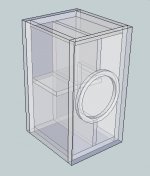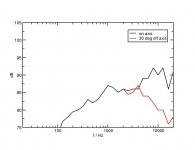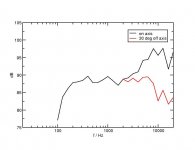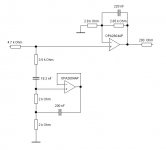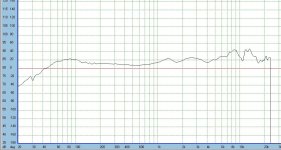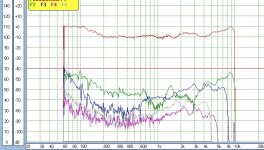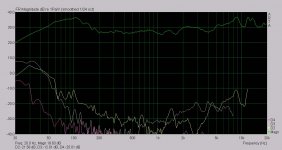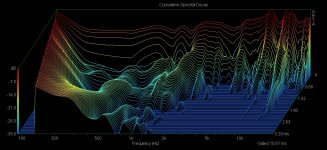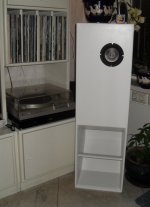If anyone feels like joining me to help develop two designs I have kicking about in my head using the E100HD and Scanspeak D2008/851100 Tweeter please speak up!
Any interest and I'll post my initial scribbles here as images and PDF files out from Sketchup.
I'm looking for support with crossover design and measurements as I have neither of these resources available to me!
Any interest and I'll post my initial scribbles here as images and PDF files out from Sketchup.
I'm looking for support with crossover design and measurements as I have neither of these resources available to me!
E100HD in a closed box
Your project sounds interesting. I am currently experimenting with the E 100HD in a small closed box. Next weekend I will perform first measurements. Later I will add a tweeter, with the option to switch between broadband and two-way mode. We can share our experience with the driver.
Your project sounds interesting. I am currently experimenting with the E 100HD in a small closed box. Next weekend I will perform first measurements. Later I will add a tweeter, with the option to switch between broadband and two-way mode. We can share our experience with the driver.
Attachments
TS were of the measured driver were very close to stated. FS was 3hz higher which is really no big deal.
Break up is dampened pretty well, and it's certainly a good midwoofer to run high up to bridge with the ribbon.
Break up is dampened pretty well, and it's certainly a good midwoofer to run high up to bridge with the ribbon.
Attachments
Wow, very impressive measurements. Could you provide me the raw data? What distance between microphone and driver did you use? what was the baffle geometry? Did you measure indoor or outdoor?
I have spent a lot of time during the last two weeks listening to the speakers. Close up (distance 1m) they produce an extremely realistic soundstage. When I increase the listening distance the reflected sound from the walls (medium size living room 30m²) becomes more important. In this configuration I have the impression that a tweeter is definitly neccessary. Until now I have no clear preference which tweeter to use. Many people like ribbon tweeters, but they are very hard to model...
I have spent a lot of time during the last two weeks listening to the speakers. Close up (distance 1m) they produce an extremely realistic soundstage. When I increase the listening distance the reflected sound from the walls (medium size living room 30m²) becomes more important. In this configuration I have the impression that a tweeter is definitly neccessary. Until now I have no clear preference which tweeter to use. Many people like ribbon tweeters, but they are very hard to model...
Wow, very impressive measurements. Could you provide me the raw data? What distance between microphone and driver did you use? what was the baffle geometry? Did you measure indoor or outdoor?
I have spent a lot of time during the last two weeks listening to the speakers. Close up (distance 1m) they produce an extremely realistic soundstage. When I increase the listening distance the reflected sound from the walls (medium size living room 30m²) becomes more important. In this configuration I have the impression that a tweeter is definitly neccessary. Until now I have no clear preference which tweeter to use. Many people like ribbon tweeters, but they are very hard to model...
I didn't save the files as FRD or SE. Only measured E100HD to see how different it is from original JX92.
But the conditions are:
Driver measured free air on a 5'x10' baffle. Near field response is taken with 500msc gating, 262144 sequence length at 1cm.
Far field at 1m 7msc gating, 65535 length, spl adjusted for gain.
Response merged at 600hz.
Distortions are taken at .5m 2.9v input signal.
Are you familiar with Jeff Bagby's PCD?
Which part of ribbon tweeter response modeling do you find harder then let's say a dome tweeter?
Last edited:
I didn't save the files as FRD or SE. Only measured E100HD to see how different it is from original JX92.
But the conditions are:
Driver measured free air on a 5'x10' baffle. Near field response is taken with 500msc gating, 262144 sequence length at 1cm.
Far field at 1m 7msc gating, 65535 length, spl adjusted for gain.
Response merged at 600hz.
Distortions are taken at .5m 2.9v input signal.
Are you familiar with Jeff Bagby's PCD?
Which part of ribbon tweeter response modeling do you find harder then let's say a dome tweeter?
With "raw data" I had some ascii table in mind. I will digitize the plot to compare it to my measured values.
I don't know the tool of Jeff Bagby. Usually I use a pencil a sheet of paper and a fortran compiler as design tools.
The amplitude and phase behaviour of dome tweeters can be modeled by a harmonic oscillator (equivalent to a second order high pass filter). By measuring the impedance, the resonance frequency and damping of the tweeter can be determined. In a crossover design, the tweeter behaviour can be used as a part of the high-pass filter (eg. one stage of a 4th order linkwith riley filter). Ribbon tweeters are more complicated to use. There is no direct possibility to link the ribbons resonance to the impedance and there are many artefacts caused by the chassis design that influence phase and amplitude.
Jeff's crossover designer tool allows you to take graphic files, trace them and use them in the crossover design. You'd need FR, phase and impedance to produce a fairly accurate model. It's popular on Parts Express Tech talk and you could get your tutorial for it there.
As far as ribbon design. You can measure frequency response distortions and impedance of the ribbon tweeter just like any other tweeters, using software package like ARTA (free without "save" option) and get the minimum phase of the measured driver. Natural roll off of most of the ribbon tweeters falls together with a strong rear chamber resonances and in my experience, pass-band of the ribbon tweeter is limited by the crossover quite a bit higher from these troublesome areas.
Here's a couple of treads with measurements.
Fountek NeoCd3.5H Horn Tweeter
Measuring Raal 140-15D
I've measured a few other ribbons and find that the most difficult issue with them is the axial performance.
As far as ribbon design. You can measure frequency response distortions and impedance of the ribbon tweeter just like any other tweeters, using software package like ARTA (free without "save" option) and get the minimum phase of the measured driver. Natural roll off of most of the ribbon tweeters falls together with a strong rear chamber resonances and in my experience, pass-band of the ribbon tweeter is limited by the crossover quite a bit higher from these troublesome areas.
Here's a couple of treads with measurements.
Fountek NeoCd3.5H Horn Tweeter
Measuring Raal 140-15D
I've measured a few other ribbons and find that the most difficult issue with them is the axial performance.
I had a look at the homepage of the tool. It sounds interesting, but since I am a linux user it is no option for me. Besides, it is not neccessary to have a specialized tool. You'll need just physics and mathematics.
Sure, you can measure the impedance of ribbon tweeters but the measurement is not sensitive to accustical properties of the ribbon. What you measure are mainly properties of the transducer. If you measure the amplitude and phase you get all information of the driver, but then you are not based on a physical model. That is what I meant with "difficult to model".
Sure, you can measure the impedance of ribbon tweeters but the measurement is not sensitive to accustical properties of the ribbon. What you measure are mainly properties of the transducer. If you measure the amplitude and phase you get all information of the driver, but then you are not based on a physical model. That is what I meant with "difficult to model".
- Status
- This old topic is closed. If you want to reopen this topic, contact a moderator using the "Report Post" button.
- Home
- Loudspeakers
- Full Range
- Anyone interested in helping with a bookshelf and floor stander using E100HD?
